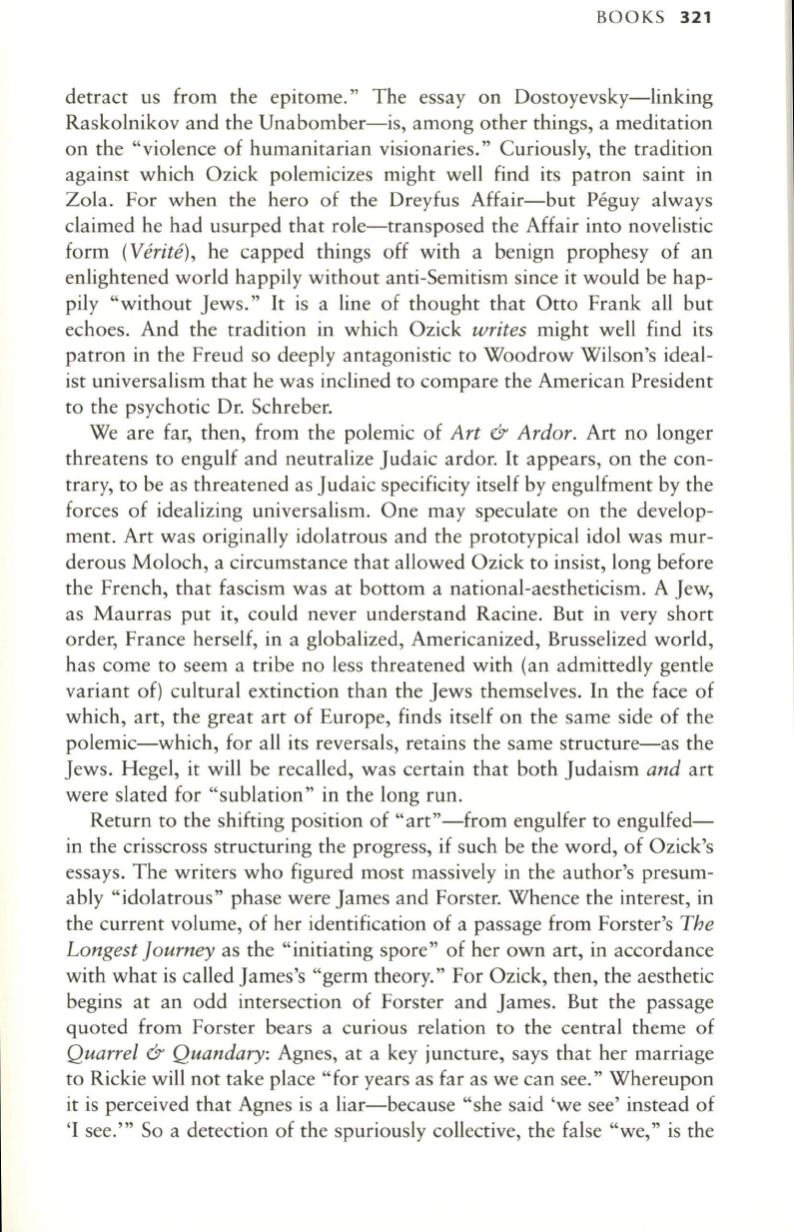
BOOKS
321
detract us from the epitome." The essay on Dostoyevsky-linking
Raskolnikov and the Unabomber-is, among other things, a meditation
on the "violence of humanitarian visionaries." Curiously, the tradition
against which Ozick polemicizes might well find its patron saint in
Zola. For when the hero of the Dreyfus Affair-but Peguy always
claimed he had usurped that role-transposed the Affair into novelistic
form
(Verite),
he capped things off with a benign prophesy of an
enlightened world happily without anti-Semitism since it would be hap–
pily "without Jews."
It
is a line of thought that Otto Frank all but
echoes. And the tradition in which Ozick
writes
might well find its
patron in the Freud so deeply antagonistic to Woodrow Wilson's ideal–
ist universalism that he was inclined
to
compare the American President
to the psychotic Dr. Schreber.
We are far, then, from the polemic of
Art
&
Ardor.
Art no longer
threatens
to
engulf and neutralize Judaic ardor.
It
appears, on the con–
trary, to be as threatened as Judaic specificity itself by engulfment by the
forces of idealizing universalism. One may speculate on the develop–
ment. Art was originally idolatrous and the prototypical idol was mur–
derous Moloch, a circumstance that allowed Ozick to insist, long before
the French, that fascism was at bottom a national-aestheticism. A Jew,
as Maurras put it, could never understand Racine. But in very short
order, France herself, in a globalized, Americanized, Brusselized world,
has come to seem a tribe no less threatened with (an admittedly gentle
variant of) cultural extinction than the Jews themselves. In the face of
which, art, the great art of Europe, finds itself on the same side of the
polemic-which, for all its reversals, retains the same structure-as the
Jews. Hegel, it will be recalled, was certain that both Judaism
and
art
were slated for "sublation" in the long run.
Return to the shifting position of "art"-from engulfer to engulfed–
in the crisscross structuring the progress, if such be the word, of Ozick's
essays. The writers who figured most massively in the author's presum–
ably "idolatrous" phase were James and Forster. Whence the interest, in
the current volume, of her identification of a passage from Forster's
The
Longest Journey
as the "initiating spore" of her own art, in accordance
with what is called James's "germ theory." For Ozick, then, the aesthetic
begins at an odd intersection of Forster and James. But the passage
quoted from Forster bears a curious relation to the central theme of
Quarrel
&
Quandary:
Agnes, at a key juncture, says that her marriage
to Rickie will not take place "for years as far as we can see." Whereupon
it is perceived that Agnes is a liar-because "she said 'we see' instead of
'I see.'" So a detection of the spuriously collective, the false "we," is the


